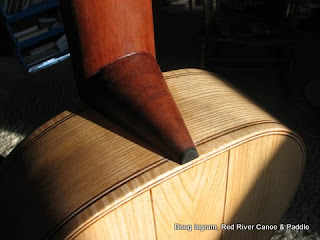









 Spent a good amount of time finishing the current batch of paddles. This is how the look at the end of Friday.
Spent a good amount of time finishing the current batch of paddles. This is how the look at the end of Friday.
 The I clamp on a mold that is prepared for each blade shape, and fill the void with epoxy thickened with milled cotton fiber. I pigment the epoxy blade because everyone knows that black goes well with everything...
The I clamp on a mold that is prepared for each blade shape, and fill the void with epoxy thickened with milled cotton fiber. I pigment the epoxy blade because everyone knows that black goes well with everything... A close up of the casting. After the mold is removed I am ready to shape the paddle blade. After the shaping is done, I cut a slot across the paddle tip, right down the middle of the blade, and insert a plate of fiberglass. This holds the whole tip together should the wood ever start to split.
A close up of the casting. After the mold is removed I am ready to shape the paddle blade. After the shaping is done, I cut a slot across the paddle tip, right down the middle of the blade, and insert a plate of fiberglass. This holds the whole tip together should the wood ever start to split.
 One of these is for my other daughter, one for a niece, and one for a friend of my elder daughter and niece. So, four of the paddles that I am working on now are for young women who will be attending Manitoba Pioneer Camp next summer. My niece and the friend will be taking their "LIT" Leader In Training course. I am mighty impresses that they valued a good paddle enough to order one!
One of these is for my other daughter, one for a niece, and one for a friend of my elder daughter and niece. So, four of the paddles that I am working on now are for young women who will be attending Manitoba Pioneer Camp next summer. My niece and the friend will be taking their "LIT" Leader In Training course. I am mighty impresses that they valued a good paddle enough to order one! Here the paddles are cut to shape, the grips are roughed out, and the bulk of the wood on the tip is cut away ready for routing for the epoxy/fiberglass tip.
Here the paddles are cut to shape, the grips are roughed out, and the bulk of the wood on the tip is cut away ready for routing for the epoxy/fiberglass tip.
 And a look at the first batch of paddles. One Birch, one Cherry, one Walnut, and one Cedar/Walnut. All good paddle woods.
And a look at the first batch of paddles. One Birch, one Cherry, one Walnut, and one Cedar/Walnut. All good paddle woods.
 The "C" bout is the one to start with. I'll do the lower bout next. Can't say when it will be done, but everything adds up!
The "C" bout is the one to start with. I'll do the lower bout next. Can't say when it will be done, but everything adds up!

 One, however, is a cedar blade which requires a more durable edge treatment. Lately, I have taken to laminating thin hardwood strips around the perimeter. However, this one is having a black epoxy border. Later I will be applying 2 oz. fiberglass.
One, however, is a cedar blade which requires a more durable edge treatment. Lately, I have taken to laminating thin hardwood strips around the perimeter. However, this one is having a black epoxy border. Later I will be applying 2 oz. fiberglass. I prepare a plywood backer which has a cutout in the center to allow it to come in full contact with the shaped paddle edge. The plywood is covered with packing tape as a mold release so that the epoxy does not stick to it. Thickened epoxy is applied around the edge. When it is cured it will be shaped as the the paddle blade edge.
I prepare a plywood backer which has a cutout in the center to allow it to come in full contact with the shaped paddle edge. The plywood is covered with packing tape as a mold release so that the epoxy does not stick to it. Thickened epoxy is applied around the edge. When it is cured it will be shaped as the the paddle blade edge.